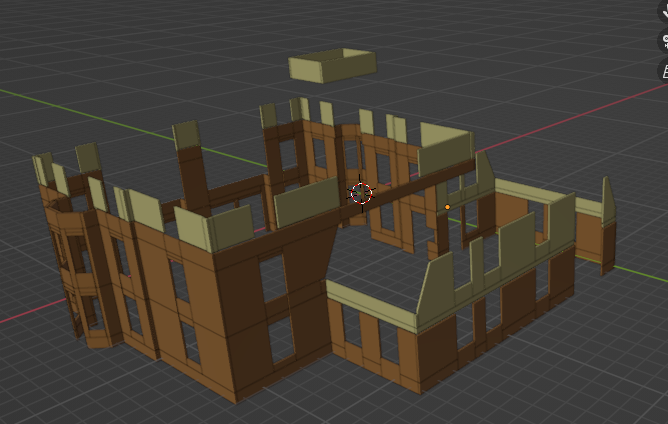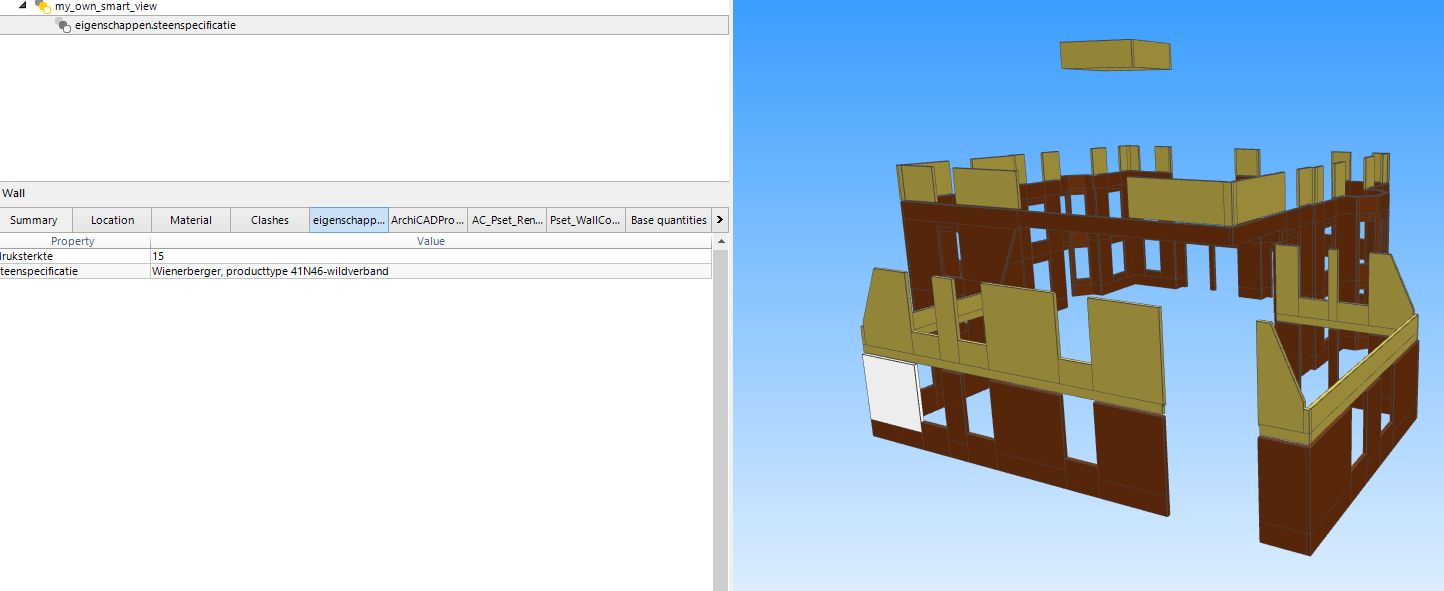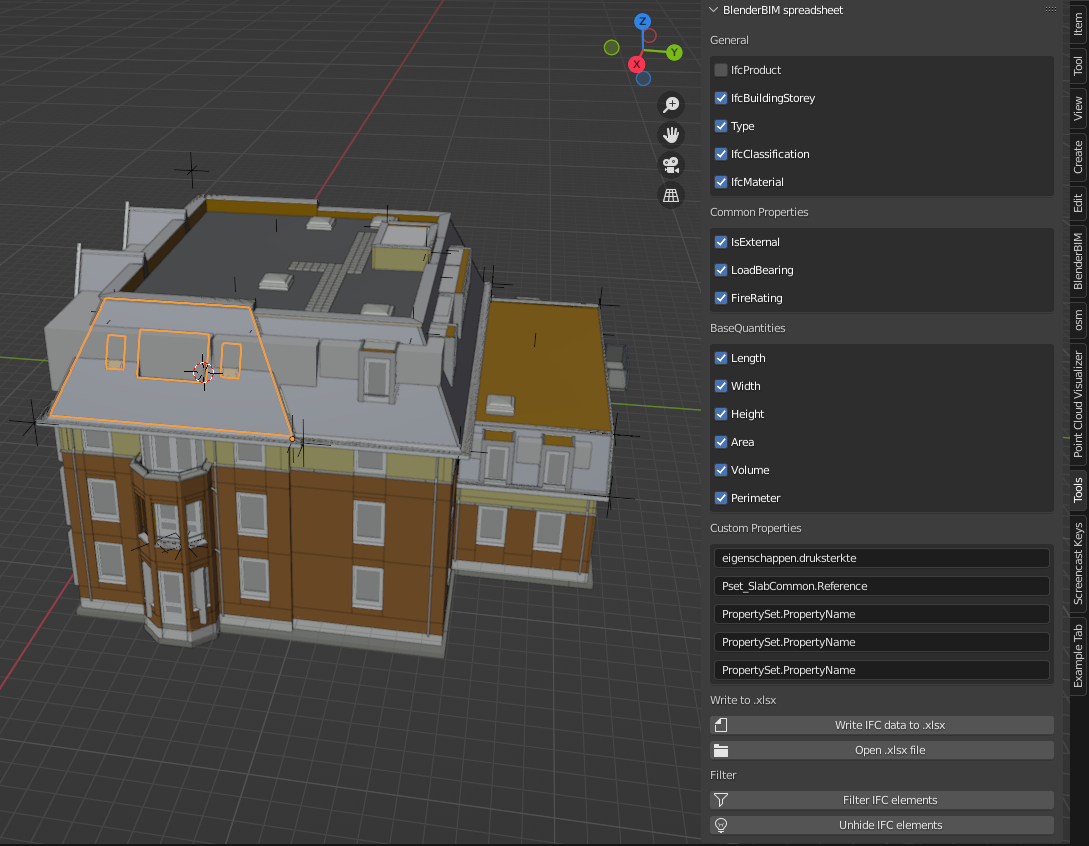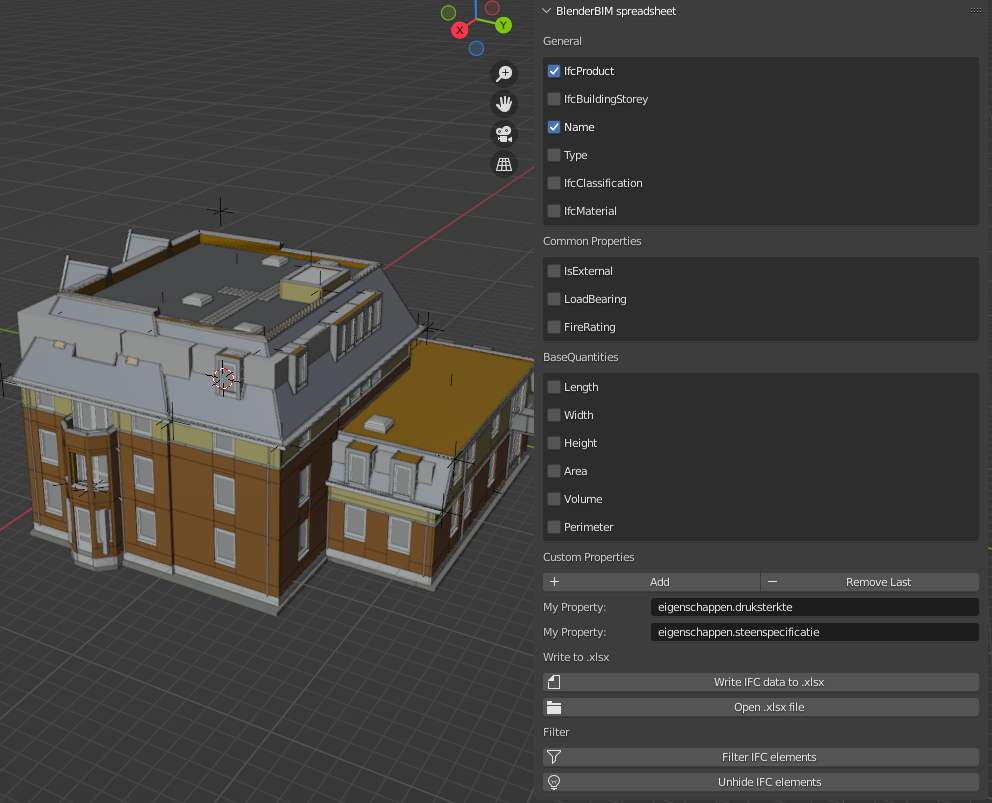BlenderBIM spreadsheet writer for .xlsx and .ods
For I begin: I decided to make a new thread, because I completely reorganized my repo, it was full of dead links and a complete mess. Hope that's okay.
I have been asking a lot of question on this forum recently and received a lot of help and good tips. This is very much appreciated. I made an add-on for BlenderBIM which creates an Open Office XML file which can be used to filter the IFC elements in Blender.
Here is an installation instruction for Windows.
If you have the time to test drive it and give me feedback we could make this a very useful add-on I think.
2022-01-31 Edit discussion name for accuracy
Tagged:









Comments
Nice ! Happy to see your work evolving and growing :)
A few python tips I can offer if you're open to it, otherwise feel free to ignore :)
In Python there is not need to test
if var == True:sinceif var:is automatically evaluated toTrueorFalsedepending on the value ofvar(in most situations at least). Similarly an empty list returnsFalsewhen boolean tested :if len(my_list) == 0:is the same asif not my_list:.You should use
if var is Noneinstead ofif var == Nonesee https://stackoverflow.com/a/3257957Now that you've figured out how to store variables on the scene properties, you can consider also using scene properties for
excel_fileandsheet_name_customso that they are notglobaland they are kept in memory in between sessions.You're generating all the data lists regardless of what the user selected or unselected before exporting. You may optimise the script by only fetching the data when you test if each individual data headers have been selected. https://github.com/C-Claus/BlenderScripts/blob/d64923a166dbd442f2bcefd7a3a6a2b572b99626/BlenderBIMOpenOfficeXML/BlenderBIMOpenOfficeXML.py#L90-L167
You have some rogue lines of codes here : https://github.com/C-Claus/BlenderScripts/blob/d64923a166dbd442f2bcefd7a3a6a2b572b99626/BlenderBIMOpenOfficeXML/BlenderBIMOpenOfficeXML.py#L253-L254
Here I think you can use
elifinstead ofifhttps://github.com/C-Claus/BlenderScripts/blob/d64923a166dbd442f2bcefd7a3a6a2b572b99626/BlenderBIMOpenOfficeXML/BlenderBIMOpenOfficeXML.py#L300-L304Instead of chaining
ifstatements you can consider usingandboolean operator, eg https://github.com/C-Claus/BlenderScripts/blob/d64923a166dbd442f2bcefd7a3a6a2b572b99626/BlenderBIMOpenOfficeXML/BlenderBIMOpenOfficeXML.py#L322-L325 If the line is too long you can escape and continue writing on the next one with\else: passcan be removed since it does nothing, but I presume it's something you added while debugging the script ?Usually it's good practice to
unregisterclasses in the reversed order from which they have beenregistered, since for instance a panel may reference an operator so the operator has to be registered before the panel, and the panel has to be unregistered before the operator. All in all it's not really important but it might prevent some warnings in the console when enabling/disabling the add-on.Cheers !
Hi @Coen great project you've got happening there.
It would be great if you used the Open Document Format which is an ISO standard developed out of the free software / opensource movement. You can read about Open Document Format on Wikipedia and at the OASIS project page. The format you've used there is xlsx which is the MS Office Open XML - it has nothing at all to do with OpenOffice and is a widely criticized file format, you can read more about it why it was criticized.
@Gorgious
Thank you very much for the code review, much appreciated!
Changed it everywhere in the scripts from
==toiswhere applicable.This is a very good point and I didn't think of this. I now have put an if statement for each check so it doesn't construct the entire pandas dataframe. Though not very elegant but effective and easy readable
Removed the lines of code
Still need to implement the other suggestions.
@duncan
I didn't know that, thanks for the heads up. To be honest, I never bothered to open a .xlsx file with notepad++. I always made the assumption they were .xml files.... it's not open source indeed and the name of the application is now misleading and wrong at the moment.
I looked into creating a .ods file
I found with pandas you can do the following:
writer = pd.ExcelWriter(excel_file, engine='odf')But the whole code relies heavily on xlsxwriter. So that might be some work before I am able to create .ods files. I found this Python module to create .ods files. But it's very light and I can't find a method to make a table or a filter. Which is quite essential to the add-on.
Hi @Coen
I like the Spreadsheet Writer Addon, would it be useful to add a warning that 'Cannot write IFC data because file is already open' with options to write new with appended filename, what do you think?
@Nigel
Yes, that's a good idea. I will implement that as well. I also like the name Spreadsheet Writer for the add-on.
finally, I am of some use to the OSArch community! haha
Would it be possible to add search & list all the Psets found in the current IFC (including custom Psets) then the user could tick/select what they require. In time 'favourites' feature could be added for when the user repeats the same operation on different IFCs.
I like this idea as well. I started very simple. The user can now export their own Property by typing their own

PropertySet.PropertyName. I saw this in the IFCCSV repo that they used a.to seperate the PropertySet from the Property.Checking in another IFC viewer to validate.

I've written this function for this, it made me think I need to refactor all the other functions to make them more robust and implement the tips from Gorgiuos
I need to figure out how to the user can add multiple custom propertyset and properties.
@Coen have a look at the ifccsv module again, you’ll see there how multiple properties can be added/deleted using collection properties. https://docs.blender.org/api/current/bpy.props.html#collection-example
As long as a switch gets onto the roadmap that would be great. Of course the earlier the better, but I'm an advocate not a developer, so I can only provide opinions.
Hi @Coen just wanted to let you know that installing modules with your script on blender installed with the windows store and opened as an admin is not possible. Windows store has the advantage that a user has always the latest version and don't need an admin/it-department to install the software for them. I've managed to get it working by installing blender regular, without the store. But perhaps there is a way to manual install the modules?
Thanks for the feedback, someone I know also used the Windows Store to install Blender. The exact same problem as you describe now. Windows need admin rights because it's downloading and installing dependencies. It also doesn't work from a Windows User account, blender console will give a [win5error].
I am going to research on how to fix it, one workaround could be to ship the python dependencies with the add-on in the zip file. If anyone has any better ideas. Please let me know.
@Meetlat
Could you please test and verify this works when Blender is installed with Microsoft Store? I updated the .zip to include the dependencies
https://github.com/C-Claus/BlenderScripts/blob/master/BlenderBIMOpenOfficeXML/BlenderBIMOpenOfficeXML.zip
Yeah seems to work! I've deleted the appdata folder to make sure I started with a fresh blender. Installed it from the store and installed both plugins without any problem. Thanks! Although the add-on manager does gives a (unnecessary) warning? See:

Thank you very much for testing, the warning is indeed unnecessary. I will remove it.
This looks awesome @Coen! It looks quite similar to IfcCSV - in that it goes from IFC->Spreadsheet, with the added awesome graphical filtering.
What other differences are there to this and IfcCSV? Would you be interested in integrating the code? Perhaps adding ODS and XLSX support to IfcCSV?
It is very similar to IFCCSV and I got some help from @vpajic . Like you said the main difference is graphical filtering. I got help from @Gorgious with the filtering and writing the add-on.
I think the differences to this and IFCCSV are the following:
Yes! very much so. Only I need to refactor the code heavily I think. I got a lot of good pointers in other threads I haven't implemented yet. Plus I already looked into adding ODS. but the add-on relies heavily on xlsxwriter and openpyxl. I can't find any python modules who are that easy to use as those python modules and are that well documented. If anyone can point me in the right direction on how to make an ods with filtering would be very much appreciated.
Yeah it would be awesome to get a slick graphical interface to IfcCSV, as well as to add an optional Pandas / dataframe feature. Feel free to submit a PR anytime and we can continue the code review process then :) I'm sure lots of people will benefit from your code!
@Coen I'd like to suggest an improvement if you're open to it.
Regarding custom properties stored on
bpy.types.Scene, you could consider putting them in a custom Property Group.eg :
There are three immediate benefits to that workflow :
my_length,my_area, etc. The chance that another addon uses the same name for their custom properties is quite high.bpy.types.Scene.bbim_openoffice_xml_props = bpy.props.PointerProperty(Type=BlenderBIMOpenOfficeXMLProperties)(example name) inregisterand thendel bpy.types.Scene.bbim_openoffice_xml_propsinunregister. That way you're sure to leave no mess when the user wants to stop using your addon.Also you can get rid of noisy prefixes like
myinmy_propby taking advantage of OOP.If you want pointers on how to achieve that I'd be happy to help.
Cheers !
@Gorgious
Thank you very much for the feedback, I have seen @LaurensJN make a simlar post in this thread
I've updated the script
I still need to remove some global variables, and I need to find out how the user can add a custom property field by clicking a + button. BlenderBIM uses this all the time I've seen. I also still need to research on how to write an ODS file.
@Moult
That would be really cool.
The add-on as it looks now:

If people could test it would be very much appreciated
Here is the link to the .zip
@Coen regarding adding custom properties using a "+", all it is is a collection property. See the example here:
https://docs.blender.org/api/current/bpy.props.html#collection-example
Notice that instead of bpy.props.PointerProperty(...) we're using bpy.props.CollectionProperty(...). An example of this with the IFC CSV module: https://github.com/IfcOpenShell/IfcOpenShell/blob/e81848dfba7885d03128224b9d4d3df7dff84ce5/src/blenderbim/blenderbim/bim/module/csv/prop.py#L37
And then a simple operator to add a new custom property:
https://github.com/IfcOpenShell/IfcOpenShell/blob/e81848dfba7885d03128224b9d4d3df7dff84ce5/src/blenderbim/blenderbim/bim/module/csv/operator.py#L31
Essentially, using a CollectionProperty creates an array. Each time you call the .add() method you create a new item in the array which is an instance of the PropertyGroup class you defined.
Accessing the array in the UI:
https://github.com/IfcOpenShell/IfcOpenShell/blob/e81848dfba7885d03128224b9d4d3df7dff84ce5/src/blenderbim/blenderbim/bim/module/csv/ui.py#L59
Hope that helps, also sorry if my explanation isn't strictly code-lingo correct ;)
This is the shortest example I could come up with :
Go to your scene properties :
And you can access the items properties with :
@Gorgious

Thank you very much, I was struggling with this.
I now need to think on how to add this to the pandas dictionary each time... I am already busy since twelve this morning. I am going for a walk.
Alright after thinking a bit about it I can suggest using defaultdic.
So you can replace this line with
ifc_dictionary = defaultdict(list)and basically remove all these expressionsAnd then for instance you can remove
and use
instead of
And for the new collection property:
in place of these lines and these lines.
@Gorgious
Thank you so much! :-D the whole script now looks a lot cleaner and more efficient using
defaultdict. No need to make a new list each time. Just committed. And now the add custom property button also works. :-D@vpajic
How would I start integrating this with IFCCSV?, I have no idea where to start..
@Coen - I would simply start by looking at the general structure of the modules. You generally have 4 files:
If you have a lot of helper functions you could also create a helper.py file and import it where necessary. I only glimpsed at your code but I saw the "WriteToXLSX" operator class and thought wow, that's a behemoth ?. Perhaps start by refactoring your script so it fits in with the other modules and then simplifying the giant classes a bit? @Gorgious might be able to give you better tips though, these are just my quick 2 cents.
@Coen there are two aspects to merge. The first aspect has got nothing to do with the BlenderBIM Add-on - it's to do with IfcCSV directly. First, I'd get familiar with how to use IfcCSV purely through Python, a CLI, or anything that doesn't require the Blender interface. IfcCSV currently only works with CSV right now. the IfcCSV class has an import function and an export function which does the actual reading and writing to and from CSV. This needs to be split out into its own function, and have two classes - one class would do CSV, and another would do XLSX. In the future, we'd also add ODS support. You'd do this refactoring and add a new XLSXWriter/Reader class and function purely in IfcCSV land. This way, any other app in the future can benefit from it: Blender, FreeCAD, or anything at all.
The second aspect would be the Blender interface that you've written. I think after you've done the first aspect and are familiar with how IfcCSV by itself works without Blender, the second aspect of integrating your UI should be much more straightforward, and you can look at the
bim/module/csv/*directory for some hints.Hope it helps.
I've done quite some refactoring . The whole script is now only 600 lines with some more efficient use of functions.
get_common_properties. I fixed a big mistake. It didn't export the loadbearing at all..get_quantitiesfunctions is now one function calledget_quantities. If the user ticks "Area" it exports all the area defintions available like NetSideArea, GrossSideArea. Maybe I should split this up in a seperate UI to prevent confusion.My plan is start integrating the add-on into BlenderBIM when I have the export to .ods export ready. Else I don't think it's worth of the term open source.
@Coen I'm inspired by the effort you put into this!
Me too, Coen I can't wait for your StairMaker ?